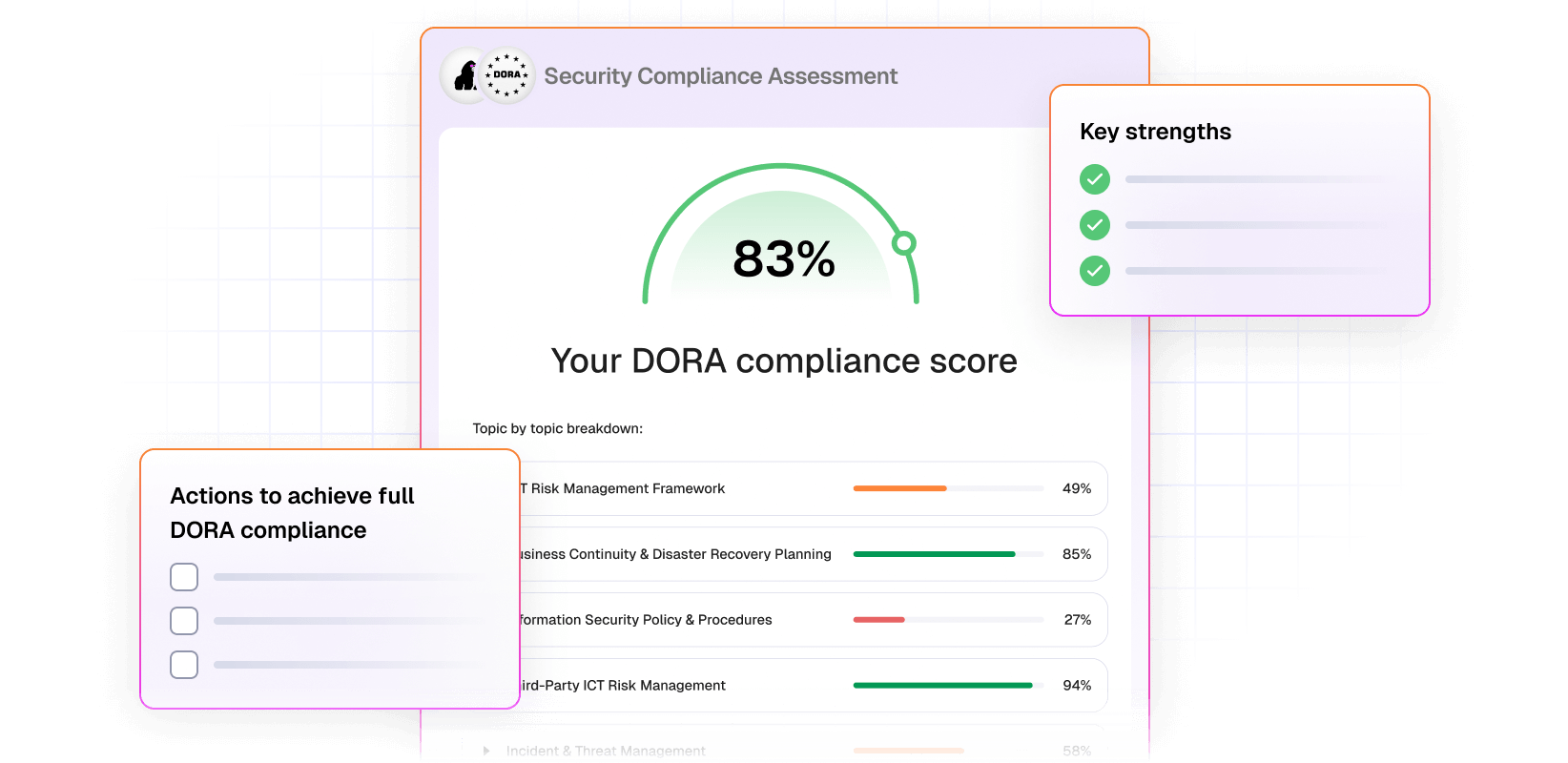A year ago, I worked with a mid-sized fintech company that underestimated the cost of non-compliance. They assumed that their modest size exempted them from regulatory scrutiny. Unfortunately, this miscalculation proved costly when a regulatory audit revealed significant deficiencies, resulting in severe penalties. This experience reinforced an essential lesson for me—and for them: no organization is too small to be impacted by mandatory regulations, such as the Digital Operational Resilience Act (DORA).
DORA, which came into effect on January 17, 2025, is now a cornerstone of the EU’s regulatory framework, and compliance is not optional—it is mandatory. Understanding the financial, administrative, and even criminal penalties it imposes is critical for all organizations operating within its scope. Ignoring compliance doesn’t just pose a legal risk—it threatens the very stability and reputation of your business.
In this article I will overview the DORA penalties framework to give clear and actionable insights on staying compliant.

Assess your DORA readiness for free!
Evaluate your organization’s compliance gaps and find areas for improvement—no prior DORA knowledge needed.
Variability across Member States
While DORA provides a consistent framework for penalties, the Article 53 states that each Member State enforces these penalties through their national competent authorities (NCAs). For example, in Lithuania, the Bank of Lithuania (Lietuvos Bankas) oversees enforcement, while in France, this responsibility is shared between the Autorité de Contrôle Prudentiel et de Résolution (ACPR) and the Autorité des Marchés Financiers (AMF). Each NCA tailors penalties to its national context, considering factors like the size of the institution and the severity of the breach.
In Ireland, for instance, DORA Act penalties may align with similar frameworks, such as the Central Bank of Ireland’s approach to regulatory enforcement. This can include substantial fines proportional to a company’s turnover or measures designed to enhance operational transparency. By contrast, regulators in Germany or France may impose different thresholds or prioritize specific compliance measures over others.
This variability reinforces the need for businesses to understand their local regulator’s expectations while adhering to DORA’s overarching principles.
The structure of DORA penalties for non-compliance
Since we’ve already established that there is variability between Member States in how DORA penalties are applied—such as differing thresholds or the prioritization of specific compliance measures—it’s important to understand how the framework guides these efforts. Currently the penalties fall into three broad categories: financial, administrative, and criminal, ensuring a comprehensive approach to addressing non-compliance.
1. Financial penalties
DORA financial penalties are among the most visible consequences of non-compliance. They are designed to deter non-compliance by imposing fines proportionate to the severity of failures. There are two articles in DORA specifying the financial penalties, namely articles 15 and 18. Both of them give a good glimpse of possible fines in case of mishandling cyber security incidents:
- Cybersecurity failures (Article 15): Fines can reach up to €2 million or 2% of annual turnover for critical lapses, such as failing to implement a cybersecurity risk management framework.
- Late incident reporting (Article 18): Companies delaying or omitting required incident reports may face fines starting at €250,000, depending on the potential systemic risk posed by the delay.
PRO TIP
Conduct regular audits of your cybersecurity framework to ensure compliance. Use external specialists to validate your readiness for incident reporting and critical system resilience.
2. Administrative penalties
Article 50 of the DORA regulation addresses repeated or serious offenders with administrative penalties, including license suspension, to prevent non-compliant entities from threatening market stability. The article also empowers regulators to impose additional cybersecurity measures, compelling organizations to address deficiencies. While less severe than license suspension, these measures are a costly but necessary step toward compliance.
- License suspension (Article 50): Repeated or severe non-compliance can lead to suspension or even revocation of operational licenses. This measure is particularly significant for fintech firms whose operations rely on uninterrupted access to financial markets.
- Mandatory corrective actions (Article 50): Regulators may require organizations to adopt specific measures, such as enhancing cybersecurity defenses or undergoing additional resilience testing, all at their own expense.
PRO TIP
Establish a dedicated compliance team or designate a compliance officer to monitor DORA requirements and interact with regulators, ensuring you stay ahead of any mandatory corrective measures.
3. Criminal penalties
While rarer, DORA criminal penalties aim to ensure accountability and deter negligence at the leadership level. As per articles 11 and article 52, executives can face these criminal penalties:
- Executive liability (Article 11): Senior executives or board members may face criminal charges for gross negligence that jeopardizes systemic stability.
- Potential imprisonment (Article 52): In extreme cases, such as wilful non-compliance leading to significant financial disruptions, imprisonment could be pursued as a last resort.
PRO TIP
Train senior executives on their legal obligations under DORA. Comprehensive workshops on accountability can prevent avoidable mistakes and highlight the importance of proactive compliance.
To give you a clearer overview, the table below highlights the key penalties under DORA and their corresponding examples:
| Category | Examples | Details |
| Financial penalties | Fines up to €2 million for cybersecurity failures | Severe lapses in risk management can attract significant fines, up to 2% of annual turnover. |
| €250,000 for late incident reporting | Timely notification is mandatory to prevent systemic risks. | |
| Administrative penalties | License suspension for non-compliance | Regulatory authorities can suspend or revoke operational licenses for persistent violations. |
| Mandatory corrective actions | Organizations may be ordered to implement compliance measures at their own cost. | |
| Criminal penalties | Executive liability for gross negligence | Directors or executives could face personal consequences for severe non-compliance. |
| Potential imprisonment for systemic risks | In extreme cases, gross negligence leading to systemic financial instability could result in jail time. |
Imagine a company that neglects mandatory resilience testing, leading to a cyberattack that disrupts services and exposes sensitive data. Regulators could impose significant fines, mandate costly corrective actions, and even suspend operational licenses, while senior executives may face accountability for negligence. This illustrates how DORA penalties are not just theoretical—they are a real and significant risk.
Searching for a third-party risk management solution?
VendorGuard ensures seamless DORA compliance.


Why the stakes are higher than ever
As we highlighted in the beginning of this article, the experience of a mid-sized fintech company that underestimated compliance underscores the risks of assuming size provides immunity from regulatory scrutiny. This serves as a reminder that understanding the specifics of regulations like DORA is crucial—relying on assumptions can lead to costly mistakes.
That being said, DORA defines a mid-sized company as an entity with fewer than 250 employees and an annual turnover not exceeding EUR 50 million or an annual balance sheet total not exceeding EUR 43 million.
This definition makes it clear that any company meeting these criteria is accountable under DORA and could face significant penalties for failing to meet resilience benchmarks, including the following:
- €500,000 in fines for insufficient third-party risk management.
- Mandatory system upgrades to comply with resilience standards.
- Temporary suspension of licenses, halting operations and alienating customers.
PRO TIP
Treat compliance as a competitive advantage. Organizations that embrace DORA’s requirements can build customer trust and position themselves as leaders in operational resilience.
The high penalties make one thing clear—DORA is not optional. It is a mandatory framework that demands a strategic approach to ensure business continuity and long-term resilience.
Examples of key non-compliance issues leading to DORA penalties
We understand that DORA is still a relatively new regulation, and navigating its requirements can feel overwhelming. That’s why we’re sharing hypothetical scenarios and insights gathered through discussions with our clients. These examples highlight the tangible risks of non-compliance, from failing to secure third-party relationships to delayed incident reporting and inadequate resilience testing, showcasing the potential penalties organizations may face for neglecting their obligations.
Failure to secure third-party relationships
Consider a scenario where a financial institution fails to conduct risk assessments of its third-party IT providers. If this results in a breach, regulators may impose fines proportional to the severity of the impact. Under DORA, such a violation could result in fines up to €500,000 for neglecting due diligence in third-party risk management.
Inadequate incident reporting
Delays or incomplete reporting of cybersecurity incidents can lead to fines starting at €250,000, escalating depending on the time elapsed and the potential damage caused by the delay. This aligns with EU-wide efforts to standardize incident reporting timelines across financial services.
Failure to conduct regular testing
Institutions that fail to conduct periodic digital resilience testing as mandated under DORA may face fines of €2 million or more, depending on the size and scale of the institution. Testing ensures operational resilience and safeguards the broader financial ecosystem.
PRO TIP
Leverage reliable compliance automation tools, such as CyberUpgrade, to streamline monitoring, reporting, and risk assessment. These tools can help reduce human error and save your compliance team significant time.
While these examples may seem intimidating, the enforcement of DORA does not mean every company is bound to face penalties. Below, we provide practical advice to help your organization stay compliant and avoid potential sanctions.
How to avoid DORA penalties
Organizations can minimize their exposure to DORA fines and other penalties by taking proactive steps:
- Understand local regulations. Stay informed about the specific enforcement policies of your Member State’s NCA. Resources like the European Commission’s DORA overview provide valuable insights.
- Develop resilience strategies. Implement robust cybersecurity frameworks, regularly test systems, and address vulnerabilities promptly.
- Conduct comprehensive risk assessments. Regularly review and mitigate vulnerabilities across systems and third-party vendors. Learn more about risk management strategies from the European Securities and Markets Authority (ESMA).
- Strengthen reporting processes. Ensure your team can swiftly and accurately report incidents to regulators. Delays or inaccuracies can lead to significant fines.
- Use a reliable cybersecurity provider. Partnering with an experienced cybersecurity provider is critical for ensuring compliance with DORA’s stringent requirements. While there are many providers to choose from, CyberUpgrade stands out as the expert in navigating the intricacies of DORA, offering tailored solutions to ensure compliance.
- Engage with regulatory authorities. Build open communication channels with regulators to ensure alignment with their expectations and avoid unnecessary penalties.
By taking proactive steps to align with DORA’s requirements, from understanding local regulations to strengthening cybersecurity and fostering communication with regulators, your organization can not only avoid penalties but also build a foundation of trust, resilience, and long-term success in the financial sector.
Avoid the high cost of DORA non-compliance
DORA penalties aren’t just financial—they impact trust, operations, and leadership accountability. CyberUpgrade helps you avoid fines, license suspensions, and executive liabilities by delivering a fully managed compliance infrastructure aligned with Articles 15, 18, and 50 of DORA. Our platform enables continuous audits, third-party risk oversight, and regulatory reporting that leaves no gaps.
Small and mid-sized fintechs are especially vulnerable, but with CyberUpgrade’s automation, they meet the same regulatory standards as major institutions—with far less overhead. We track enforcement trends across EU Member States and tailor guidance to your local regulatory environment, so you’re never caught off guard.
Whether it’s €2 million in cybersecurity fines, €250,000 for late incident reporting, or mandatory system upgrades, CyberUpgrade keeps your business ahead of DORA enforcement. Don’t risk learning the hard way—get compliant, stay compliant, and protect your company’s future.
The high cost of non-compliance
The key takeaway is that DORA comes to life from extensive efforts to address cybersecurity challenges and protect the financial ecosystem. While its foundation is built on good intentions, the penalties for non-compliance can feel intimidating. However, these concerns can be alleviated with a proactive approach. By implementing robust strategies and leveraging reliable cybersecurity tools, organizations can navigate DORA’s requirements confidently, avoiding fines and fostering long-term resilience and trust.
Are you prepared to meet the challenges of DORA? Or will you let penalties define your compliance journey?

Assess your DORA readiness for free!
Evaluate your organization’s compliance gaps and find areas for improvement—no prior DORA knowledge needed.









